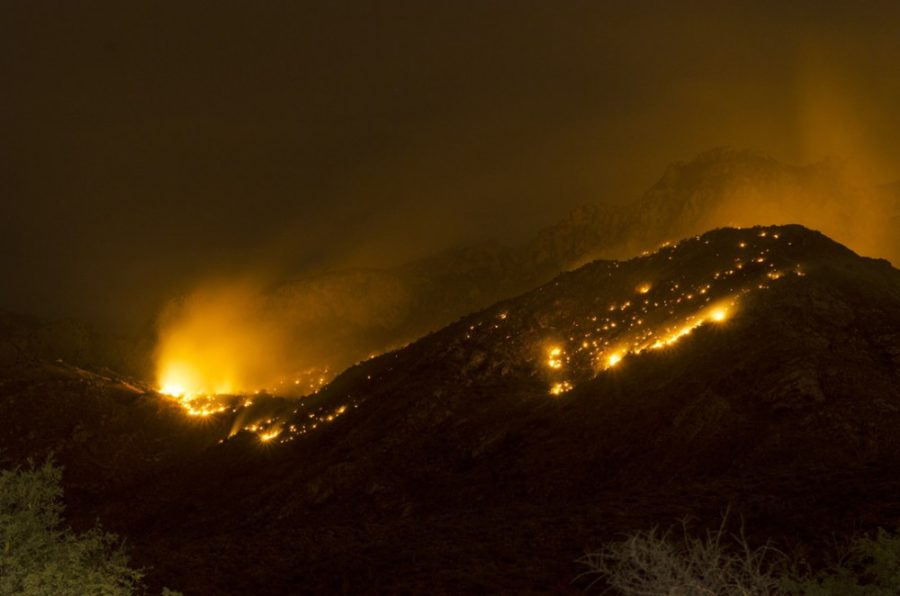Wildfire season in Arizona is gaining traction, and four major wildfires — the Bighorn Fire in the Santa Catalina Mountains near Tucson, the Tortolita Fire just north of Tucson, the Blue River Fire near Alpine and the Sawtooth Fire just east of Phoenix — are currently lighting up areas of southern and central Arizona.
According to Tiffany Davila, a public affairs officer for the Arizona Department of Forestry and Fire Management, 93,000 acres of land have been engulfed in wildfires from the first day of 2020 until June 6.
This is an increase from the 35,000 acres that were subjected to wildfires during the same time period last year. This 58,000 increase in acres burned during this time corresponds with an increase in the number of wildfires, 619 to 867, according to Davila.
“We are really concerned with the number of fire starts that we’re seeing; 867 compared to 619 last year is a huge jump in numbers, especially for this time of the year,” Davila explained. “What also is concerning is that with the conditions that they’re running through — the dry vegetation, the extreme heat we’ve had, the winds, the low humidity — upon ignition fires are starting very quickly.”
In southern and central Arizona, lightning has been the cause of a number of wildfires including the Bighorn Fire, the Tortolita Fire, the Blue River Fire and the Sawtooth Fire. Davila said most of the wildfires from this year have been caused by lightning.
After lightning strikes from Friday night’s storm around Tucson, the Bighorn Fire erupted and has now reached over 2,000 acres. According to the Arizona Emergency Information Network, smoke from the Bighorn Fire is projected to drift into Tucson.
About 20 miles northwest of the Bighorn Fire, the Tortolita Fire has burnt through nearly twice the acreage. This was also caused during Friday night’s lightning storm. The fire has reached up to 3,500 acres. The Arizona Department of Forestry and Fire Management is hoping to mitigate the fire through full suppression.
Near Alpine, the Blue River Fire continues to burn and is projected to continue growing. Over 18,500 acres have been burned.
In the Superstition Wilderness, 40 miles east of Phoenix, the Sawtooth Fire has reached just under 25,000 acres. Fortunately, the Sawtooth Fire is about 80% contained, according to the Fire, Weather & Avalanche Center.
In the past couple of weeks, there have been other significant fires as well. These include the Range Fire in Pinal County started on the National Guard Firing Range, the Sunset Fire along Interstate 17 just north of Black Canyon City, the East Desert Fire east of Phoenix and the Jackrabbit Fire close to Wickenburg. Additionally, the Ocotillo Fire of Cave Creek burnt down a number of homes and the Jeep tour business Carefree Adventures.
All of these fires can be partially attributed to climatic conditions. According to Davila, moisture resulting from rain during the winter of 2019 created overgrowth in grass and vegetation considered as “fine fuels.” Fine fuels are characterized by the National Fire Coordinating Group as “fast-drying dead or live fuels” that “ignite readily and are consumed rapidly by fire when dry.”
“Fine fuels don’t hold a lot of moisture to begin with. So once it heats up, those fuels dry up very quickly, coupled with the warmer than normal temperatures we saw at the end of April fires were popping very quick across the state,” Davila said.
RELATED: Arizona sees record-high increase in number of COVID-19 cases
Davila emphasized that even though much of the wildfires have been caused by lightning and environmental circumstances, the public must play their part in preventing wildfires.
“It is a two-way street,” Davila said. “We work throughout the year to mitigate overgrown fuels across the state, to conduct prescribed burns, to help with rehabilitation, to reduce that risk of wildfire, to reinvigorate the desert areas and forests, but people also need to do their part to help us out.”
People can do this by creating defensible space around property to protect from wildfires, adhering to the Stage II fire restrictions in Arizona and staying educated on wildfire information across the state.
Follow Quinn McVeigh on Twitter









